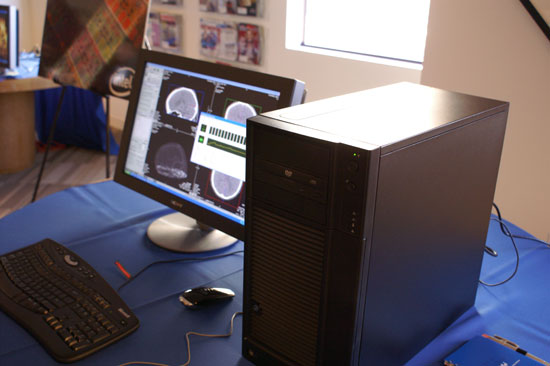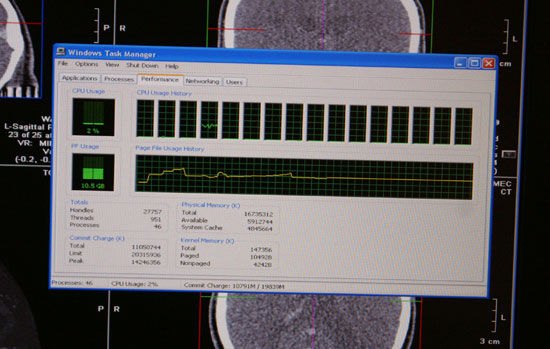Opening the Kimono: Intel Details Nehalem and Tempts with Larrabee
by Anand Lal Shimpi on March 17, 2008 5:00 PM EST- Posted in
- CPUs
In the usual Intel fashion, it had systems based on Nehalem and Dunnington up and running live demos:

Above we have a one socket, 4 core (8 thread) Nehalem system running a custom graphics demo:

Intel avoided running any real benchmarks most likely to prevent us drawing any early conclusions. Clock speeds weren't reported, but given the transistor counts of Nehalem we'd expect similar clocks to what we've seen with Penryn.

Here we have a two socket Nehalem system, that's 8 cores, 16 threads:











53 Comments
View All Comments
haplo602 - Tuesday, March 18, 2008 - link
I wonder what the real world usage will be. I mean first you need to get Microsoft to code a new version of Windows to eat all that horse power. Then you are back at the begining... You have more cores but Windows is using most of them again (or not using all of them in case of old version).Anyway I don't see any significant benefits of these CPUs except highend server and workstation load.
Consumer will drift more into the console or memory/specialised processing unit (GPU, sound processors ...) markets ...
oldhoss - Tuesday, March 18, 2008 - link
The screwdriver is actually fuel for the IFRPS (Intel Fusion Reactor power supply), rated @ 1.21 Jigawatts! ;-Pbrshoemak - Monday, March 17, 2008 - link
I assume I'm not the only one who notices the glass of OJ on the 4 core Nehalem system? Kinda odd as I doubt they carry a lot of spares around.ryback - Tuesday, March 18, 2008 - link
It's not OJ. It's a screwdriver.tmouse - Tuesday, March 18, 2008 - link
Its part of the new processor cooling system. Also Intel's additional strategy Tick, Tock, Crock : enough alcohol = even BETTER coverage by the press ;)7Enigma - Tuesday, March 18, 2008 - link
HAHAHAHA! Very nice.Imaginer - Monday, March 17, 2008 - link
With intel doing things that way, I would expect the PC platform to finally have a standard instruction set for graphics processing similar to general purpose computing with the x86 standard. Would that mean that it would be ALOT EAISER for game developers to produce for the PC akin the way they are doing right now specializing for a particular console?I like that idea very much. Hopefully AMD/ATi and Nvidia would eventually be in on the standard as well.
Griswold - Tuesday, March 18, 2008 - link
I too think you got it all wrong on that one. See the other comment.kaddar - Monday, March 17, 2008 - link
No, because in general game development isn't done on instruction sets or assembly, it's done in programming languages utilizing API's. Specifically, DirectX or OpenGL. The architecture is abstracted away, and rightly so.Nihility - Monday, March 17, 2008 - link
Sounds pretty exciting. The huge cache on the Penryn procs does a pretty good job of negating the side effects of the slower memory interconnect so I'd be surprised if we see huge gains from Nehalem just because of the memory part as it wasn't that big of a bottleneck. Probably see more benefits on the server side. However, 8 cores is definitely a treat.